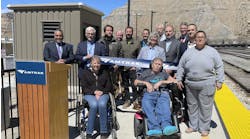While assaults on operators may be rare in the Indianapolis area, IndyGo wants its operators to be prepared for the worst. In 2010 the agency developed a training program that handles self defense and it is now included in the agency’s annual in-service training that all bus operators must go through.
“That’s a time when we bring in every single coach operator we have once a year, we take them off their regularly scheduled work and have them come in for eight hours of refresher training. Each time we have the sessions we look at what are the needs; it can be anything from farebox training to conflict resolution to customer service training and we identified self defense in 2010 as kind of a anchor point for the class. From there forward we've done it as initial training as well for everybody,” explains IndyGo Director of Human Resources Mike Birch. When the self defense training began, Birch was IndyGo’s director of Security & Safety Training.
The training spurred from operator input on the issue. “It seemed to be a hot topic. It’s obviously a hot topic throughout the industry. I think the operators talk from different transit properties and it gets perpetuated,” Birch says. “We just thought it was a great way to equip them with some extra tools and also remind them of the escalating hostile situations because they can very quickly turn deadly.”
IndyGo worked with Jeff Patterson who is the lead instructor for defense techniques for the Indianapolis Metropolitan Police Department. He also is a partner of Escape Plan (http://anescapeplan.com/), a company that provides defense training for corporations.
“Jeff is actually a friend of mine and he came in and did some counseling with us to look at our specific situation, and he recommended some really good techniques. He helped us out quite a bit,” Birch says.
Training consists of three main parts: a review of Indiana state law as well as laws that concern self defense and using reasonable force; de-escalation or conflict resolution for issues with a disruptive passenger; and finally a self-defense technique to use if the situation turns physical.
Birch says Part Two is probably the biggest part of the training. “When a customer does something, how we respond to it, how we address the common problems," Birch says is critical. To teach the operators how to de-escalate these situations, Birch says they use what he describes as a flow chart decision-making tree. The basic structure of the chart follows the pattern if a customer does this, then we respond by doing this.
“It ramps all the way up to using force. It starts off very simple with something like a passenger brings an open cup of coffee aboard the bus, how do you address it? Or a person who gets on and doesn’t pay a full fare, how do you address it with that person,” explains Birch. “We actually have a little mini script that goes with it. We deal with more and more complicated situations to the point where now it’s time to actually use some sort of force.”
Birch says that in IndyGo’s experience, a passenger attacking an operator in a random act of violence is somewhat rare. Usually, some sort of event precipitates a fight occurring. “We’re trying to identify those early events and trying to de-escalate them before the ramp up to a full-fledged assault. It’s kind of the nuisance stuff: short-paying the fare, intoxicated passengers, breaking some of our rules or not conforming to the rules of riding transit,” he explains. “It’s our theory, or our contention, that that’s how fights start. It’s these back-and-forth exchanges between a customer and the operator. If they continue to go unchecked they can bubble up to the point where someone sees red for a second and throws a punch and we have an assault situation.”
“In our industry we don’t always know who our passenger is, where they came from or what just happened to them five minutes before they get on the bus and we want our operators to be physically prepared to defend themselves if somebody attempts to harm them in some certain way.”
One of the major benefits of the training program is the confidence it gives operators to handle some of the nontraditional situations that are out there. Birch says operators no longer need to feel like they are expected to just sit there and take whatever abuse is meted out to them. He says the program has empowered them to take action by de-escalating situations, recognizing early on that a situation is potentially hostile or dangerous and then using techniques they learned to mitigate some of the risks.
“Then, if it does come to where it’s an actual assault, having some sort of technique is really important,” Birch says.
Birch explains that the defense tactic the operators are taught is simple to do.
“I credit Jeff Patterson and the fine work that his organization did in helping us develop it. It’s really hard to develop a self-defense technique that anyone can do. Obviously we have some older drivers here, we have small drivers, we have some very large drivers, so trying to find a technique that could benefit everyone was really important to us. They were able to help us with that. I think that was a huge success, finding the right technique because it is simple to do. It’s really easy, it’s not very flamboyant. It doesn’t look like Bruce Lee karate chopping a bunch of people; it’s nothing like that. It’s very controlled, very conservative and very effective.”


